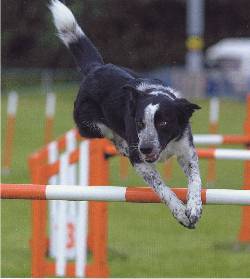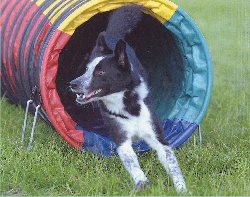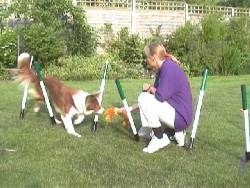|
Co-sponsors of the 2023 Winning Out
Certificates



| |
Start as
you mean to go on...
 From
the start Casey was very difficult. Before Lesley and Colin Harpley brought her home from
Chilterns Dog Rescue Society, she had been left in a flat for 12 hours a day whilst her owner
worked. She had not been socialised nor house trained at all. In addition, when she showed
signs of nervous aggression to people and dogs, while at the same time being quite dominant.
Lesley explains how they got over the problem. From
the start Casey was very difficult. Before Lesley and Colin Harpley brought her home from
Chilterns Dog Rescue Society, she had been left in a flat for 12 hours a day whilst her owner
worked. She had not been socialised nor house trained at all. In addition, when she showed
signs of nervous aggression to people and dogs, while at the same time being quite dominant.
Lesley explains how they got over the problem.
Casey was quite nervous when we
tried training her at home, and would run off and stand looking at them from a distance. She
would also do things like barging through to the front of our pack, snapping and biting at our
other dogs on the way in or out of the house.
Fair but firm
We decided to be ‘fair but firm,’ establishing the ground rules from Day One. There was no way
we were having Casey bite the other dogs and barge ahead, and anyway, she was far too nervous
and unskilled socially to be top dog. So, everything we did was to reinforce her place at the
bottom of our pack.
We made her wait to go out behind us
and the other dogs, fed her last (but only just after) the other dogs etc etc. If she did bite
at one of the others, we immediately put her on her side firmly and pinned her down to
emphasise her position and give one of the more extreme calming signals. We were more gentle,
of course, with her agility training but still ensured we reinforced the positive and desired
behaviours rather than the negative ones.
One evening, Colin and I sat on the
grass ‘ignoring her’ for 20 minutes after Casey ran off a few yards in apparent fear. We then
rewarded her greatly with treats and fuss when she eventually crept round close to us. It was
really hard to tell if Casey was genuinely afraid, or whether she was exhibiting signs of
‘submissive dominance’. Either way, we felt that there was no point in chasing after her, as it
would only reinforce the undesired behaviour and she was perfectly safe, if uncertain, standing
several yards away.
A further factor is that, of all our
dogs, Casey has the strongest 'work ethic' and instinctive herding tendency. We had to learn to
distinguish this from her otherwise anti-social behaviour. We tried to separate her instinctive
'sheepdog' behaviour from anxiety induced and unacceptable behaviour.
Training
results in behaviour modification
We took her to training pretty much straight away. I realise that some people may feel this is
debatable, but we wanted to be quite consistent with her from the start and in our experience,
rescued dogs suss out their environment and the ground rules pretty much in the first month, so
we didn’t want to go through a second problem phase. Again, we were firm but fair with her and
did it in a controlled and safe environment with support from other handlers. It was so
upsetting to see Casey so afraid that she would evacuate her bowels literally where she sat
when other dogs came through the door at obedience training, but we felt we had to get through
that barrier. So, we neither overly pacified her, nor (of course) told her off. It was all very
‘matter of fact’. Thankfully we had some great support from Aylesbury and MAD clubs in this
aspect and after two or three weeks she had acclimatised.
In agility, it was more ‘exciting’
of course. Casey would snarl and snap at other dogs within three yards of her and we did make
it clear that was unacceptable by making her ‘settle’ and saying ‘no’ whilst trying not to
‘overdo it’ and reinforce the fear. She never made contact with another dog, and often bit her
own tongue in her frenzy, ending up with blood all down chest. It took a couple of months but
the wonderful thing is that two years on Casey is now so happy and well adjusted and we love to
see her charging around with an extended pack in the exercise area with no problems at all.
 Follow
the leader Follow
the leader
At home, we found it helped for Casey to watch the other dogs work first, and sense
that they were enjoying it and unafraid. This goes against some advice about training one dog
at a time, but it really seemed to help. For example, Casey was terrified of the floppy tunnel
and got so distressed when I held her and tried to encourage her through that I backed right of
and sent Star in a few times. When Colin held the end open, Casey just followed Star right
through!
I’m not suggesting that this formula
would work for every dog, since every case will be different. Some of what we did was quite
structured, in the sense of positive and negative reinforcement, pack structure and leadership,
but obviously a lot of it was quite intuitive too and we probably didn’t even notice a lot of
the things we instinctively did.
Casey is much more affectionate now,
but a very quick cuddle is all she needs. She is almost like the pig in Babe, where a curt
'That’ll do pig' in the form of a quiet 'good girl' will send her leaping into Colin’s arms.
Anything more enthusiastic from us either goes over her head or makes her stressed.
Interestingly, she calmed down the
most when we got Mace. That might be a coincidence, but I think she took on the task of the
next youngest dog ‘training’ the baby and it somehow made her ‘belong’. Maybe, after all is
said and done, it is the other dogs in our ‘packs’ that do so much of the social training for
our newcomers and what we do is only the tip of the iceberg.
So how is she
doing now?
Before having her spell of slipping weaves, Casey
won out of Elementary and Starters in her first few shows. She now consistently gets top ten
places in Novice, both in Agility and Jumping, and I was absolutely thrilled to get a first
place in a Brace Pairs event with Casey and Star at the RVA show in June 2003. (Colin reckons
it was all down to his efficient change-over!) But I think the crowning moment fro Casey was
when she passed her Silver KC Good Citizen with Colin in April this year, allowing the examiner
to handler her and check her east and feet.
We still have to maintain our
consistent approach as Casey is quite prepared to push the boundaries whenever she thinks that
she can get away with it! But overall she is a totally different dog to the one we rescued two
years ago.
 About
the author... About
the author...
Lesley Harpley is one of the team of Instructors at Aylesbury CTS, where the club
has a great variety of rescued and mixed breed dogs as well as some rather lovely pedigree
dogs!
Return to Weaving Case Studies
| |
|